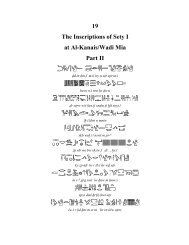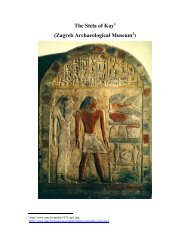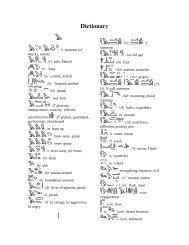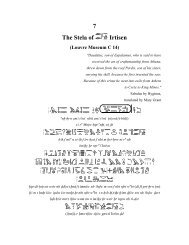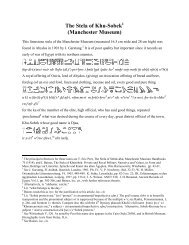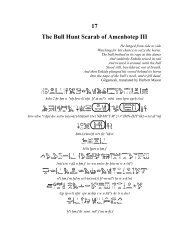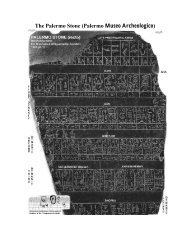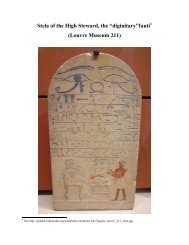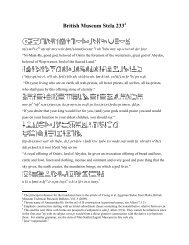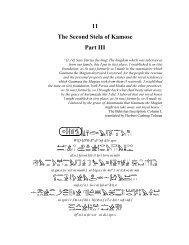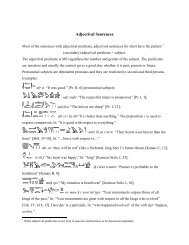King Den's Royal Jubilee Label (British Museum) King Den's name ...
King Den's Royal Jubilee Label (British Museum) King Den's name ...
King Den's Royal Jubilee Label (British Museum) King Den's name ...
Create successful ePaper yourself
Turn your PDF publications into a flip-book with our unique Google optimized e-Paper software.
<strong>King</strong> Den’s <strong>Royal</strong> <strong>Jubilee</strong> <strong>Label</strong> 1<br />
(<strong>British</strong> <strong>Museum</strong>)<br />
<strong>King</strong> Den’s <strong>name</strong> dn in the serekh with Horus on the<br />
top is clearly visible in the center. 2 To the right the king<br />
himself is sitting in a small dais (wearing the double crown<br />
and holding a flail) as well as running his Heb-Sed race<br />
(between 6 territorial markers or cairns Dnb representing<br />
his kingdom). 3 Note the sign rnp, year, arching over the<br />
1 Principal sources: W. Helck, Untersuchungen zur Thinitenzeit (1987), p.159, D. Wengrow, The invention<br />
of writing in Egypt, in E. Teeter (ed.), Before the Pyramids, Oriental Institute <strong>Museum</strong> Publications 33,<br />
Chicago (2011), and http://xoomer.virgilio.it/francescoraf/hesyra/labels/xxden16.htm.<br />
2 For the meaning of the <strong>name</strong>, see <strong>King</strong> Den’s Hippopotamus Ivory Sandal <strong>Label</strong> in this web site.<br />
3<br />
For a detailed discussion on the sign and its significance in the Heb-Sed race, see J. Spencer, JEA, 64<br />
(1978), pp. 52-55.
heb-sed court with obvious meaning: The year of ... In the<br />
register under the court the verb wp open, inaugurate<br />
and a fortified enclosure underneath are clearly visible.<br />
The fortress surrounds aA an beautiful door (with the<br />
painted eye determinative missing) perhaps representing the<br />
inauguration of a fortress. The signs … mrw rn… are<br />
difficult to read. On another label, 4 however, the seated<br />
woman is directly under the sign and is followed by the<br />
clearly readable rnp, youth.<br />
By analogy, the subject is then clearly a young women,<br />
most probably a princess, and mrw, pain, can be interpreted<br />
as ailment, sickness. The sem-priest directly following the<br />
princess further supports this. The upper part of this register<br />
clearly starts with in(t), carrying (infinitive, common in<br />
headings), and the following signs may be smt which,<br />
with a bit of stretch, can be read as Ssmt, malachite. The<br />
following sledge may point to the means of transportation<br />
of this precious mineral. (For example, in a stela from Wadi<br />
El-Hudi 5 the verb sTA drag, pull is used to describe the<br />
transportation of aromatic oils and resins. There is also<br />
pictorial evidence that this has been carried out using<br />
sledges.)<br />
In the register below nswt-biti clearly readable, and<br />
4 Abydos, Umm el Qa'ab T; O.I. Chicago 6.126; Petrie R.T. I pl. 11.15; 15.17.<br />
5 See A. D. Espinel, JEA, 91 (2005), pp. 55-70.
the following xAsti or zmti (both are feminine duals) is<br />
the (first attested) prenomen of <strong>King</strong> Den. ( zmt, desert,<br />
necropolis, sometimes written only with the determinative<br />
is also attested in the title imi-r smwt iAbtt, overseer of<br />
the eastern deserts.) This prenomen (with a t at the end)<br />
also occurs in several other jar labels: 6<br />
The rest of this register contains (bird) offerings or tributes<br />
to the king.<br />
On the left of the serekh xtmj bjtj HmAkA, is the<br />
royal seal bearer (treasurer or chancellor) of Lower Egypt<br />
Hemaka (his tomb was found in Saqqara).<br />
Under Hemaka’s <strong>name</strong> st(i)-wr THnw HAtt<br />
1200 xt, st(i)-wr is a kind of fine oil from THnw, Lybia. The<br />
quality is expressed by HAtt, foremost, good, and the<br />
quantity is 1200 with obscure measurement (probably a<br />
sub-multiple of palm). The two 100 signs are not clearly<br />
readable, but they are also present on other labels: 7<br />
6 Abydos, Umm el Qa'ab T; Petrie R.T. I, pl. 14.9; 10.14.<br />
7 Abydos, Umm el Qa'ab T, O.I.Chicago 6.125; Petrie R.T. I, pl. 11.4; 15.18.
(Note also the combination xt-idt HAt on another label<br />
fragment.)<br />
In the leftmost column the sign in the building indicate<br />
oil-press, the signs above are obscure. On another label, in a<br />
similar composition, the sign is clearly nbw, gold: 8<br />
By analogy, it can be translated as the golden enclosure of<br />
the oil-press. Hwt-(n)sw(t) in direct genitive means that<br />
this oil press is part of the royal palace. Finally,<br />
(n)sw(t)-mDHti (i)Tisn is the royal carpenter Itisen.<br />
8 Abydos, Umm el Qa'ab T; Petrie R.T. I pl. 15.14.



